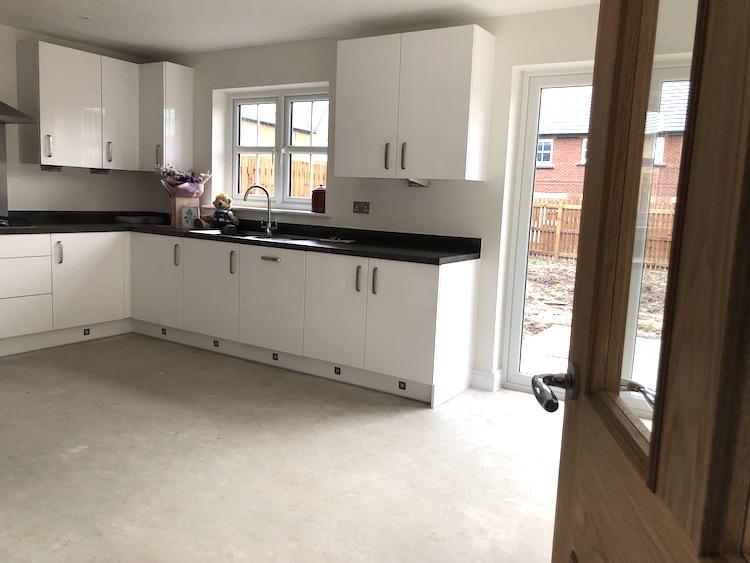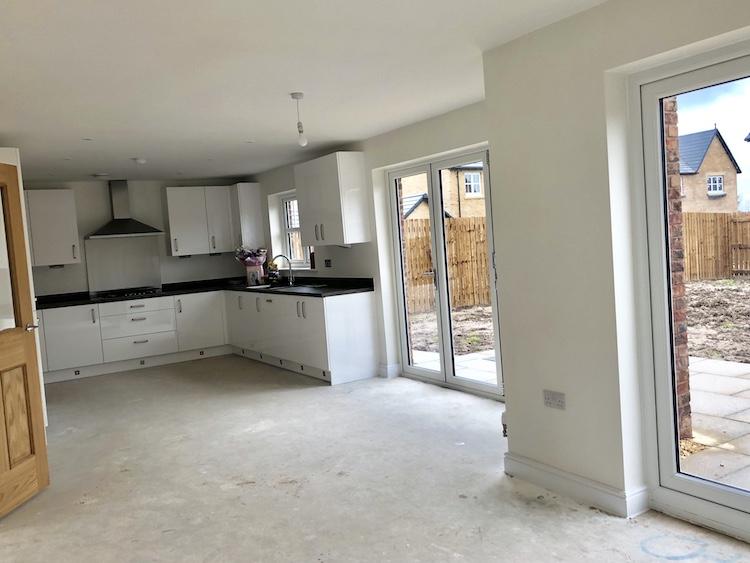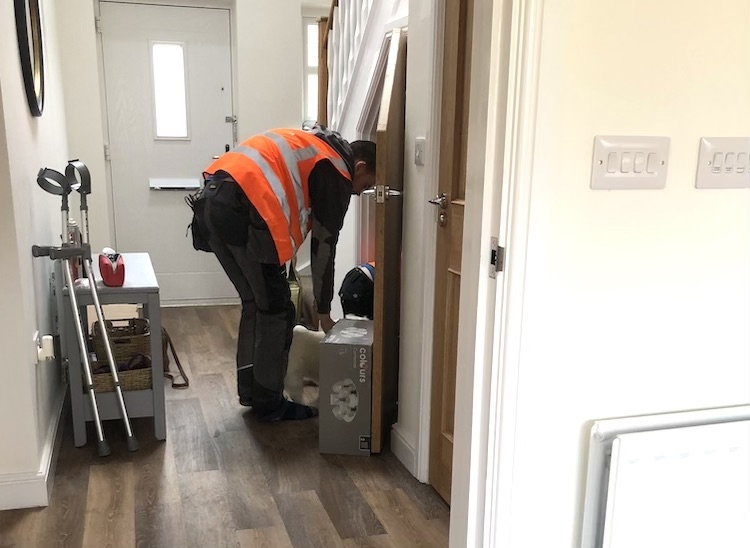
Today I’m sharing top tips for snagging a new build home yourself.
We moved into our new build just over a year ago. It was the first time I’d lived in anything other than a period house, so snagging was a new concept to me. Here’s a post about moving in, and another after a month of living in our new home.
“Snagging” is the process of checking over a new build property and identifying any small (or medium or big) issues that need to be resolved.
Snagging Tips: Things to Remember About Snagging
- First, you are buying a brand new house. With brand new windows, and cupboards, and paintwork. It’s reasonable for you to expect those things to be immaculate.
- Second, you’re buying a house that was built by people, who are fallible and sometimes forget things or make mistakes. So it’s probably not reasonable to expect everything to be immaculate, right away.
- Third, it’s important to do snagging as early as possible. The longer you’re in a house before snagging happens, the more likely it is that a builder will claim the issues were caused by removal men, or you.
Pick Your Moment
There’s a huge benefit to snagging a new build house before you move in. It’s harder to snag when there’s furniture and rugs covering things up. It’s also impossible for a builder to blame you for any issues if you haven’t been living in the house.
Some builders will give you access for snagging once you’ve exchanged but our builder, Story Homes would not give us access before completion.

We completed on Friday and stayed with family for four days, so the snagging could be done on Monday (as well as carpets being fitted). If you’re completing and moving in on the same day, at least try and get the removals team to hold fire for a couple of hours while you inspect the house.
Be Methodical
When you go to start snagging a new build, bring along some basic supplies – you’ll need a spirit level, torch, and camera/phone. In addition, I recommend bringing a pad of paper with a page for each room, plus another page for the exterior. On each page, you want to put the following headings:
- Carpentry
- Decoration
- Fixtures & Fittings
- Plumbing and Electrical
Snagging Tips for a New Build Home’s Exterior
Although you’ll be dying to get inside your new house, spend some time walking around the outside of the house.
Look at the brickwork – pointing should be a little rough, but even between the bricks. Any cabinets like the gas cabinet, should be square to the ground, and sealed around the edges. Check doors, windows and sills – are they level, in good order and with the right seals around the edges. Can you see the air bricks? Are they at the right level?

As to the roof, look at all elevations in case of slipped, chipped or missing tiles.
Check paving, paths and driveways – they should be level, with sand between blocks, and no breaks or cracks. If there is turf, it should be level, and there shouldn’t be any areas of pooled water.
Finally, check the garage. Does the door open, close and lock as expected? Is the floor level, and in good condition?
How to Check Joinery in a New Build House
If you are snagging a new build, approach each room with a plan, starting with joinery. Look at the doors – are they square, have they been sanded down properly, do the handles and locks work, are they secure?
In the kitchen look at cupboards, especially doors, which are easily damaged during installation. Are they square? Do the worktop pieces meet smoothly? Are the lines of cupboards level with the ceiling?
Check the Decoration in a New Build
One of the most common faults found when snagging a new build is issues with decor – painting, filling, sealing etc. When looking at paintwork, you shouldn’t see brushworks and there should be two coats applied. Check around sockets and switches and around door frames for poor finishes. Make a note of any marks you spot, or any early shrinkage cracks.
Fixtures and Fittings
A common issue with new builds can be scratches, mostly on appliances and windows. These can be notoriously difficult to spot, so look at shiny or reflective surfaces closely, and from different angles. It’s important to snag these problems early as otherwise builders may well try to argue YOU caused the damage.
Snagging Tips for Plumbing
Unless you’re a plumber, you can’t fully check plumbing when snagging a new build, but you can look at the basics. Check that pipes are boxed in and tiling is done properly. Then turn on taps and fill sinks – check the overflow is connected, and that water drains well (it’s not unheard of to find rubble in sink, bath and shower pipes).
Check that taps are secure, and look at cupboards underneath sinks – if they’re damp, it might indicate a leak. Radiators should be free of damage and the radiator in the same room as the thermostat shouldn’t have a thermostatic valve.
Check Basic Electrics for Snags
When snagging a new build, you can’t really do a full electrical survey. But do look at switches and sockets. Check they are level, and boxes are fitted cleanly to the wall. If you can, check against the plans to make sure sockets and switches are placed correctly – this may be important when it comes to placing furniture. Switch lights on and off to make sure they’re all connected.

Don’t Forget the Loft!
As soon as you can, get a ladder and explore the loft. The key things to look for are:
- Is the loft space insulated fully? Insulation should be across the entire floor surface, at least 27cm deep.
- Keep an eye for condensation on the roof lining – this might indicate the liner isn’t breathable. Also look for any gaps or tears.
- You may spot a ventilation tube in the roof, check if it is connected to the pipe coming up from the bathroom below.
Make a List
Once you have your full list (with supporting photos) send it to the builder. My advice is to have the builder respond to the list in writing – if it’s done over the phone, immediately send an email to the builder to “confirm what was discussed in our telephone conversation today”.
The important thing is to note which snags the builder agrees to fix. Our builder (Story Homes) – was great and accepted all the snags, without any issues. You may find that your builder will claim some snags are not faults, because they’re “within tolerance”. This means it meets the standards set by organisations like NHBC.

Check on Repairs
Several of the snagging repairs created knock-on issues that had to be noted and reported to the builder. The guy replacing a shower screen trashed the paintwork bringing it upstairs. The guy repairing a leak under the sink caused some damage to the worktop. A broken tile that was replaced promptly fell off, leaving a gap. Small things, but not things I want to sort our myself.
Every week, I re-sent the builder our snagging list, crossing out issues that had been addressed, and drawing attention to any new snags we’d added to the list (along with photos).
How Long Should Builders Take to Fix Snags?
If builders are on site, it is much quicker to fix snags. Once a development is finished, a tradesman has to be booked specifically for a job, rather than just popping in during a spare moment. In our case, I’d say we had about a third of snags fixed in the first month, then the remaining snags mostly over the next nine months.
We’ve been in the house for 13 month now and I’m waiting for a broken roof tile to be repaired, and the kitchen worktop to be repaired but overall we’re really happy with our house. I’m so pleased we invested time and money in proper snagging from the start. If you’re just starting snagging on a new build home then best of luck!






You honestly sound like the most horrid person ever.. How can you do more than one snag list and expect tradesman to continuouslly come round to your house. You’ve probably. Cost construction workers loads of money you petty *****.
I’m assuming you don’t know the UK process of buying a new build house but it’s 100% standard for the buyer to have a snag list which builders are responsible for addressing in the first two years. This list just means you don’t need to pay a surveyor £500 to do the snagging check for you, silly!